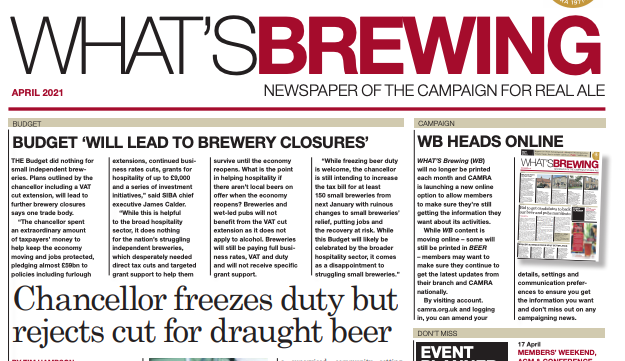Consumers lead the way on green beer
Audio Description
Login here to listen to the audio description

As part of CAMRA’s ‘Drink Greener’ campaign, the Environmental Working Group looks at the environmental impact of brewing to understand how consumers can make greener choices.
The best environmental solution is, of course, not to release any greenhouse gases, but for most manufacturing this is unavoidable and brewing beer is no exception. To look at the carbon footprint of a beer it is necessary to include the complete supply chain from ‘grain to glass’.
Sources of carbon dioxide emissions when producing a beer
Brewing materials account for around 20 – 30 per cent of the total footprint, with three quarters of the CO2 coming from barley alone. The impact of greenhouse gas emissions can be reduced through better soil management, growing cover crops, using green fertilizers, no till cultivation, crop rotation and reverting to old barley varieties.
Brewing operations account for around 12 per cent of the total footprint, with electrical energy used for pumps and controls and gas for wort boiling and cleaning. Changing to a renewable supply of electricity and using biogas or renewable wood burners could eliminate most of the greenhouse gas emissions.
Packaging accounts for between five and 45 per cent of the total footprint, depending on the type of packaging chosen. Recyclable bulk units such as casks and kegs have a smaller carbon footprint, while small pack beers in bottles and cans require more resources and energy even when recycled content is considered.
Distribution & Retail accounts for around 15 per cent of the total footprint. The best way to reduce the environmental impact is by:
- Drinking local beers especially in a brewery taproom.
- Using electric vehicles and distribution hubs to reduce transport miles.
- Minimising the energy required for cooling and storing beer in trade or in the refrigerator at home.
Breweries cannot achieve net carbon zero production at present without some form of offsetting which means buying or investing in external carbon credits. This must be done thoughtfully, and the ultimate objective should be reducing dependence on carbon offsetting through investment and technology.
So what does this mean for consumers?
All this means that the consumption of a pint of cask beer releases only around one third of the harmful, climate changing, gases compared to the same beer sold in a non-returnable bottle.
How we travel, store, and consume the beer will also contribute to the total greenhouse gas emissions, which means we can influence our environmental impact as consumers too.
Walking or cycling to the pub and drinking a pint of locally brewed cask conditioned beer served at 10 – 140C through a hand pull with no added CO2 is the most environmentally responsible option. While driving to the pub in a large 4x4 and drinking a bottle of imported lager extra cold (3 – 50C) dispensed under carbon dioxide or mix gas would represent the least sustainable option.
CAMRA members already choose to visit the pub and select cask conditioned beers in preference to carbonated beers as they are a tastier more natural drink.
The good news is that this is also the friendliest environmental choice!
The road to a carbon zero future
Since 1900 the average surface temperatures increased by 1.20C. Climate scientist consider any increase beyond 1.50C (the maximum target temperature set by the Paris Accord for 2100) would be catastrophic. We must all be more carbon conscious and through efforts from industry and changes in behaviour we can make a difference to achieve a carbon zero future.
Brewers’ agricultural resilience can be increased by looking after the soil through intercropping, mixed cultivation, planting traditional varieties, crop rotation, accepting lower yield, and favouring organic cultivation. This will have the added benefits of improving biodiversity. Where possible brewing materials can be sourced from local suppliers and growers.
Draught beers consumed in a pub have lower emissions than small pack, and as ales require less energy and require less refrigeration than lagers, CAMRA has a part to play in encouraging more consumers to enjoy live beer in pubs and social clubs.
We must move to reduce, reuse, and recycle packaging. As well as the role of consumers in recycling waste, local councils have a responsibility of collecting and recycling industrial and local waste.
We can encourage breweries to embark on a carbon zero journey and complete an annual carbon footprint audit which will form the basis of a continual improvement programme and influence investment decisions.
It is up to all of us to take responsibility and look after and cherish our planet to make sure our children and our children’s children can enjoy a pint of real ale in their local just as we can today.
Tim O’Rourke is a member of CAMRA’s Environmental Working Group and founder of training company Brilliant Beer.

 view archive
view archive
 view events
view events